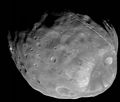Datei:Phobos colour 2008.jpg

Grate faan detdiar föörskaubil: 636 × 600 pixel. Ööder apliasangen: 255 × 240 pixel | 509 × 480 pixel | 815 × 768 pixel | 1.086 × 1.024 pixel | 2.172 × 2.048 pixel | 3.500 × 3.300 pixel.
Originaal datei (3.500 × 3.300 pixels, dateigrate: 2,72 MB, MIME-typ: image/jpeg)
Datei wersioonen
Klike üüb en tidjponkt, am detdiar wersion uuntulukin.
| Dootem/Tidj | Föörskaubil | Miaten | Brüker | Komentaar | |
|---|---|---|---|---|---|
| aktuel | 05:10, 2. Apr. 2018 |  | 3.500 × 3.300 (2,72 MB) | Kaldari | more margin on right side |
| 06:47, 13. Nof. 2008 |  | 3.374 × 3.300 (2,7 MB) | Fir0002 | == Summary == {{Information |Description=Colour image of Phobos, imaged by the Mars Reconnaisance Orbiter in 2008 |Source=NASA |Date=9 April 2008 |Location=http://www.nasa.gov/mission_pages/MRO/multimedia/pia10368.html |Author=NASA/J |
Hü det datei brükt woort
Detdiar sidj brükt detdiar datei:
Globaal brük faan datein
Jodiar ööder Wikis brük detdiar datei:
- Brük üüb af.wikipedia.org
- Brük üüb an.wikipedia.org
- Brük üüb ar.wikipedia.org
- المريخ
- فوبوس
- قمرا المريخ
- ويكيبيديا:صور مختارة/الفضاء والكون/نظرة إلى الأعلى
- قائمة أجرام المجموعة الشمسية مرتبة حسب الحجم
- بوابة:علم الفلك/صورة مختارة
- بوابة:المريخ
- بوابة:المريخ/مقالة مختارة/أرشيف
- بوابة:المريخ/مقالة مختارة/2
- قائمة الأقمار الطبيعية
- خط زمني لاكتشاف كواكب المجموعة الشمسية وأقمارها
- ويكيبيديا:ترشيحات الصور المختارة/القمر فوبوس
- ويكيبيديا:صورة اليوم المختارة/أغسطس 2019
- قالب:صورة اليوم المختارة/2019-08-03
- بوابة:علم الفلك/صورة مختارة/73
- معسكر قاعدة المريخ
- ويكيبيديا:صورة اليوم المختارة/يناير 2022
- قالب:صورة اليوم المختارة/2022-01-04
- Brük üüb ary.wikipedia.org
- Brük üüb arz.wikipedia.org
- Brük üüb as.wikipedia.org
- Brük üüb azb.wikipedia.org
- Brük üüb az.wikipedia.org
- Brük üüb be-tarask.wikipedia.org
- Brük üüb be.wikipedia.org
- Brük üüb bg.wikipedia.org
- Brük üüb bh.wikipedia.org
- Brük üüb bn.wikipedia.org
- Brük üüb bn.wikibooks.org
- Brük üüb bs.wikipedia.org
Muar globaal brük faan detdiar datei.





